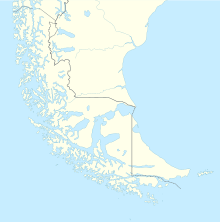Viedma Glacier facts for kids
Quick facts for kids Viedma Glacier |
|
|---|---|

The Viedma glacier (tan) flows into Lake Viedma (light blue). (NASA)
|
|
| Type | Valley glacier |
| Location | Santa Cruz Province, Argentina Magallanes y la Antártica Chilena, Chile |
| Coordinates | 49°27′36″S 73°11′42″W / 49.46°S 73.195°W |
| Terminus | Lake Viedma |
The Viedma Glacier is a giant river of ice. It's part of a huge ice area called the Southern Patagonian Ice Field, found at the very bottom of South America.
This glacier is a type called a valley glacier. Its end, which is full of rocks and dirt, flows right into Lake Viedma. The lake gets most of its water from the melting ice of the glacier. The Viedma Glacier is located where Argentina and Chile meet. In Argentina, it's part of Los Glaciares National Park. This park became a World Heritage Site in 1981, meaning it's a very special place protected by the world. Part of the glacier is also in Chile's Bernardo O'Higgins National Park. The entire Southern Patagonian Ice Field is about 13,000 square kilometers (5,000 square miles). Viedma Glacier is one of 48 large glaciers that flow out from this huge ice field.
The End of the Glacier
The end of the Viedma Glacier is about 2 kilometers (1.2 miles) wide where it enters Lake Viedma. Large pieces of ice break off the glacier and float into the lake. This process is called ice calving. These ice chunks eventually melt.
Glaciers pick up soil and rocks as they move. These materials are called moraines. They collect in front of and along the sides of the glacier.
You can see dark lines inside the white part of the Viedma Glacier. These lines show where the rocky moraines have mixed into the ice. You can also see large cracks, like canyons, in the grey-brown ice along the sides. These cracks are called crevasses. They form because the ice near the valley walls moves slower due to friction. The ice in the center moves faster, causing stress and cracks. On the southwestern side of the glacier's end, you can see ice breaking off into the lake. The glacier ends in a steep ice cliff.
See also
 In Spanish: Glaciar Viedma para niños
In Spanish: Glaciar Viedma para niños


